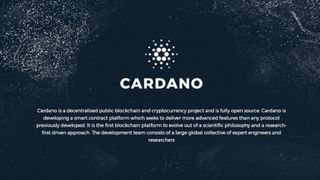6 cryptocurrencies that could become the next Bitcoin
Virtual currency pretenders waiting in the wings

Cryptocurrencies continue to vex investors, while simultaneously crowning new millionaires in this challenging time. While Bitcoin is the dominant virtual currency that grabs much of the attention, there are plenty of other cryptocurrencies out there, some of which are also popular and relatively high-profile such as Ethereum and Ripple. But there are many lesser known virtual coins, too; literally thousands of them.
While it remains relatively uncommon to actually purchase anything with these virtual currencies, there’s still plenty of money that could potentially be made with these more obscure coins that have been likened to the ‘penny stocks’ of the cryptocurrency world – and the right one could be due for a meteoric rise.
Here are six potential contenders which could be on the verge of heading up, up and away, but as ever, note that you make any investment in this volatile arena at your own risk.
1. Bitcoin Cash (BCH)
Bitcoin Cash was forked from the original Bitcoin in August 2017, and currently has a market cap of $28 billion (£20 billion). The goal was to create a newer version of Bitcoin with a larger block size, as the original was limited to 1MB, which in turn limited the network to processing Bitcoin transactions at only seven per second, a severe restriction as Bitcoin increases in popularity.
The creators view Bitcoin Cash as the next step on in terms of the evolution of the virtual currency, offering the promise of faster peer-to-peer transactions, with lower processing fees. The ultimate goal of Bitcoin Cash is to be actually useful as a digital currency for purchases in the real world.

2. Litecoin (LTC)
Litecoin dates back to 2011, and was created by ex-Google engineer Charlie Lee. It is often thought of as the ‘little brother’ to Bitcoin – a kind of silver to Bitcoin’s gold, if you will – with a current market cap of $10 billion (£7 billion), and a hard limit of 84 million Litecoin ever to be issued.
Like Bitcoin, Litecoin is a decentralized cryptocurrency that allows for peer-to-peer transactions. However, Bitcoin is based on the SHA-256 algorithm, while Litecoin uses the Scrypt algorithm, which runs considerably faster, with a target of 2.5 minutes for each new Litecoin block (Bitcoin takes 10 minutes for each new block).
Are you a pro? Subscribe to our newsletter
Sign up to the TechRadar Pro newsletter to get all the top news, opinion, features and guidance your business needs to succeed!
The result is that Litecoin boasts faster transactions, and at a lower cost compared to Bitcoin, which are certainly favorable points when it comes to Litecoin’s potential growth.
3. Monero (XMR)
Monero is an open source, crowdfunded approach to cryptocurrency, which dates back to July 2012. It was originally called Bitmonero, but this was subsequently shortened to the current name. Monero is a decentralized virtual currency based on the CryptoNote algorithm, with a new block added every two minutes, meaning it offers faster transactions than Bitcoin.
Another advantage of Monero, compared to Bitcoin, is that Monero is fungible, and therefore transactions are private, and there are no ‘tainted’ coins. Finally, Monero is resistant to ASIC mining, so it’s not as easily mined by professional mining companies, which keeps it decentralized.
4. IOTA (MIOTA)
IOTA is getting some attention these days, following its release as an alternative cryptocurrency back in 2014. The name derives from ‘Internet Of Things Application’, and this virtual currency was developed for a future where IoT devices trade their resources and services directly with each other, and IOTA is used for the payment. It’s a cryptocurrency which was designed to offer efficient, low-cost microtransactions.
Other cryptocurrencies are based on the blockchain, with recent transactions bundled into the new block. IOTA takes an alternative approach via a Directed Acrylic Graph (DAG) which is called Tangle.
In order to perform a transaction via IOTA, the user has to participate in the network, and they do this by verifying the last two transactions. This allows IOTA to offer free transactions, and furthermore allows it to scale – because as it becomes more popular, there will be more folks to verify transactions.
As the world of cryptocurrency matures, and transitions from a mere investment vehicle to being used to make real-world payments, IOTA’s unique approach and free transaction fees, especially for micropayments, mean it’s well positioned. Another point to note is that IOTA cannot be mined, as all IOTA was created in a single original transaction.

5. Cardano (ADA)
Cardano is a relative newcomer, having been released in 2017 following a lengthy ‘initial coin offering’ from 2015. Considered a third-generation cryptocurrency, its name comes from Gerolamo Cardano, a Renaissance figure who was an Italian mathematician and physician. Its founder is Charles Hoskinson, who was a co-founder of Ethereum.
Cardano is blockchain-based, and takes a scientific approach to cryptocurrency, being based on published academic papers with academic institutions overseeing its growth and evolution. Their goal is to balance the needs of regulation, while still adhering to privacy and decentralization principles.
This virtual currency also features the Ouroboros ‘Proof of Stake’ (PoS) method for faster transactions, which is laudably energy-efficient. Furthermore, it’s considered highly secure, as it’s based on a layered architecture. Cardano is an ambitious project that seeks to address the shortcomings of Ethereum and other older cryptocurrencies.
Thus far, Cardano certainly seems to be doing something right, as it has quickly become the fifth biggest cryptocurrency going by market cap value (behind Bitcoin, Ethereum, Ripple and Bitcoin Cash respectively).
6. Vertcoin (VTC)
Vertcoin was launched in 2014, and is similar to Bitcoin and Litecoin, although it’s certainly not as well-known. Vertcoin is open source, decentralized, and has a block time of 2.5 minutes. It also endeavors to be ‘the peoples’ coin’.
In other words, Vertcoin wants to avoid control by banks or other centralized mining powers. It incorporates ASIC resistance, meaning it’s designed to avoid being dominated by mining farms, allowing everyone the opportunity to mine using simple consumer graphics cards.
Vertcoin also utilizes the Lightning Network for instant blockchain transactions. Additionally, the Lightning Network has the ‘Atomic Cross-Chain’ which allows Vertcoin to be exchanged directly into either Litecoin or Bitcoin, decentralizing the exchanges. The creators are also working on ‘Stealth Addresses’ which allows them to provide privacy within the public ledger of the blockchain.
Two other factors contribute to the popularity of Vertcoin. The first is that it has an active community on social media sites, and the other big plus is that it’s easily mined by novices using one-click software, making it highly accessible.
- We show you how to mine Bitcoins and you can secure them using one of the best VPN services we've identified
Jonas P. DeMuro is a freelance reviewer covering wireless networking hardware.
Most Popular


